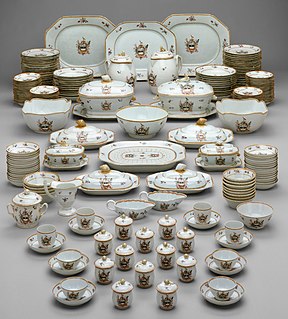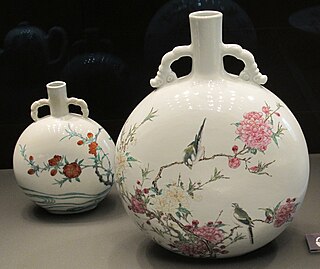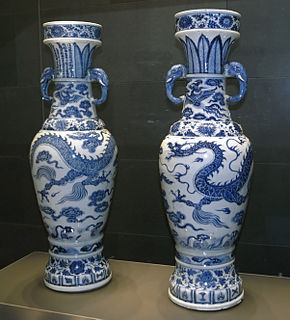 W
WChinese ceramics show a continuous development since pre-dynastic times and are one of the most significant forms of Chinese art and ceramics globally. The first pottery was made during the Palaeolithic era. Chinese ceramics range from construction materials such as bricks and tiles, to hand-built pottery vessels fired in bonfires or kilns, to the sophisticated Chinese porcelain wares made for the imperial court and for export. Porcelain was a Chinese invention and is so identified with China that it is still called "china" in everyday English usage.
 W
WAn hua is a term used in Chinese ceramics meaning secret or veiled decoration; the designs being visible through transmitted light, produced either by incising the design into the porcelain before glazing and firing or by delicate slip-trailing in white slip on the porcelain body. It is also called "secret" or "hidden decoration".
 W
WArmorial ware or heraldic china are ceramics decorated with a coat of arms, either that of a family, or an institution or place. Armorials have been popular on European pottery from the Middle Ages with examples seen on Spanish Hispano-Moresque ware, Italian maiolica, slipware, English and Dutch Delft, and on porcelain from the 18th century. Earlier examples were mostly large pieces such as jugs or basins and ewers, but later whole table services, all painted with the arms, were produced.
 W
W"Blue and white pottery" covers a wide range of white pottery and porcelain decorated under the glaze with a blue pigment, generally cobalt oxide. The decoration is commonly applied by hand, originally by brush painting, but nowadays by stencilling or by transfer-printing, though other methods of application have also been used. The cobalt pigment is one of the very few that can withstand the highest firing temperatures that are required, in particular for porcelain, which partly accounts for its long-lasting popularity. Historically, many other colours required overglaze decoration and then a second firing at a lower temperature to fix that.
 W
WCanton or Cantonese porcelain is the characteristic style of ceramic ware decorated in Guangzhou, the capital of Guangdong and the sole legal port for export of Chinese goods to Europe. As such, it was one of the major forms of exportware produced in China in the 18th and 20th centuries.
 W
WA Chicken Cup (Chenghua) is a bowl-shaped vessel made of Chinese porcelain painted in the doucai technique. Chicken cups were created during the Ming dynasty, during the Chenghua Emperor's reign in China, and originally functioned as a vessel to drink wine from. Chenghua Chicken Cups were created in an imperial kiln in the Jingdezhen porcelain factory, in Southern China. The Emperor Chenghua had the Chicken Cup created in the 15th century as an act of devotion for his empress mother who was recorded to have an appreciation for small objects and valued a simple design taste.
 W
WA chinaman is a dealer in porcelain and chinaware, especially in 18th-century London, where this was a recognised trade; a "toyman" dealt additionally in fashionable trifles, such as snuffboxes. Chinamen bought large quantities of Chinese export porcelain and Japanese export porcelain landed by the East India Company, who held auctions twice a year in London. The traders then distributed chinaware throughout England.
 W
WChinese export porcelain includes a wide range of Chinese porcelain that was made (almost) exclusively for export to Europe and later to North America between the 16th and the 20th century. Whether wares made for non-Western markets are covered by the term depends on context. Chinese ceramics made mainly for export go back to the Tang dynasty if not earlier, though initially they may not be regarded as porcelain.
 W
WChinese influences on Islamic pottery cover a period starting from at least the 8th century CE to the 19th century. This influence of Chinese ceramics has to be viewed in the broader context of the considerable importance of Chinese culture on Islamic arts in general.
 W
WChinese porcelain in European painting is known from the 16th century, following the importation of Chinese porcelain wares into Europe.
 W
WA cong is a form of ancient Chinese jade artifact. It was later also used in ceramics.
 W
WSir Percival Victor David Ezekiel David, 2nd Baronet was a Bombay-born British financier who is best known as a scholar and collector of Chinese ceramics. He also formed a collection of Chinese stamps and postal history that has been evaluated as one of the greatest ever assembled.
 W
WDehua porcelain, more traditionally known in the West as Blanc de Chine, is a type of white Chinese porcelain, made at Dehua in the Fujian province. It has been produced from the Ming dynasty (1368–1644) to the present day. Large quantities arrived in Europe as Chinese export porcelain in the early 18th century and it was copied at Meissen and elsewhere. It was also exported to Japan in large quantities.
 W
WDing ware, Ting ware or Dingyao are Chinese ceramics, mostly porcelain, that were produced in the prefecture of Dingzhou in Hebei in northern China. The main kilns were at Jiancicun or Jianci in Quyang County. They were produced between the Tang and Yuan dynasties of imperial China, though their finest period was in the 11th century, under the Northern Song. The kilns "were in almost constant operation from the early eighth until the mid-fourteenth century."
 W
WDoucai is a technique in painted Chinese porcelain, where parts of the design, and some outlines of the rest, are painted in underglaze blue, and the piece is then glazed and fired. The rest of the design is then added in overglaze enamels of different colours and the piece fired again at a lower temperature of about 850°C to 900°C.
 W
WFamille jaune, noire, rose, verte are terms used in the West to classify Chinese porcelain of the Qing dynasty by the dominant colour of its enamel palette. These wares were initially grouped under the French names of famille verte, and famille rose introduced by Albert Jacquemart in 1862. The other terms famille jaune (yellow) and famille noire (black) may have been introduced later by dealers or collectors and they are generally considered subcategories of famille verte. Famille verte porcelain was produced mainly during the Kangxi era, while famille rose porcelain was popular in the 18th and 19th century. Much of the Chinese production was Jingdezhen porcelain, and a large proportion were made for export to the West, but some of the finest were made for the Imperial court.
 W
WFamille rose is a type of Chinese porcelain first introduced in the 18th century and defined by the presence of pink colour overglaze enamel. It is a Western classification for Qing dynasty porcelain known in Chinese by various terms: fencai, ruancai, yangcai, and falangcai. The colour palette was introduced in China during the reign of Kangxi (1654–1722) by Western Jesuits who worked at the palace, but perfected only in the Yongzheng era when the finest pieces were made.
 W
WA gaiwan or zhong (盅) is a Chinese lidded bowl without handle used for the infusion of tea leaves and the consumption of tea. It was invented during the Ming dynasty. It consists of a bowl, a lid, and a saucer.
 W
WJingdezhen porcelain is Chinese porcelain produced in or near Jingdezhen in southern China. Jingdezhen may have produced pottery as early as the sixth century CE, though it is named after the reign name of Emperor Zhenzong, in whose reign it became a major kiln site, around 1004. By the 14th century it had become the largest centre of production of Chinese porcelain, which it has remained, increasing its dominance in subsequent centuries. From the Ming period onwards, official kilns in Jingdezhen were controlled by the emperor, making imperial porcelain in large quantity for the court and the emperor to give as gifts.
 W
WKraak ware or Kraak porcelain is a type of Chinese export porcelain produced mainly in the late Ming Dynasty, in the Wanli reign (1573–1620), but also in the Tianqi (1620–1627) and the Chongzhen (1627–1644). It was among the first Chinese export wares to arrive in Europe in mass quantities, and was frequently featured in Dutch Golden Age paintings of still life subjects with foreign luxuries.
 W
WA meiping is a type of vase in Chinese ceramics. It is traditionally used to display branches of plum blossoms. The meiping was first made of stoneware during the Tang dynasty (618–907). It was originally used as a wine vessel, but since the Song dynasty (960–1279) it also became popular as a plum vase and got its name "meiping". It is tall, with a narrow base spreading gracefully into a wide body, followed by a sharply-rounded shoulder, a short and narrow neck, and a small opening.
 W
WThe Meiyintang Collection is a large, privately owned collection of Chinese porcelain consisting of about 2,000 pieces. The Meiyintang was widely hailed as one of the last great collections of Chinese porcelain by European owners. The collection is currently controlled by Stephen Zuellig, a Swiss businessman and the heirs of his late brother, Gilbert Zuellig. Meiyintang 玫茵堂 is the adopted Chinese name of the collection and means "Hall among Rosebeds" in Mandarin. The Zuellig family also collected Chinese bronzes of the Shang, Zhou and Warring States periods.
 W
WMing presentation porcelain was a variety of high quality Chinese porcelain items included among the gifts exchanged in foreign relations during the Ming Dynasty. Among the great number and variety of Chinese ceramics found in Thailand and greater Southeast Asia is a variety that closely resembles Ming official ware in its use of dragon and phoenix motifs and high quality materials with workmanship.
 W
WThe Percival David Foundation of Chinese Art holds a collection of Chinese ceramics and related items assembled by Percival David that are on permanent display in a dedicated gallery in Room 95 at the British Museum. The Foundation's main purpose is to promote the study and teaching of Chinese art and culture. The collection consists of some 1,700 pieces, mostly of Song, Yuan, Ming and Qing dynasty porcelain from the 10th century to the 18th. It includes a painting, Scroll of Antiquities.
 W
WPorcelain Palace is a large public toilet complex at the Foreigners' Street amusement park in the city of Chongqing, China.
 W
WPorcelain trade in Qing China was an important trade during the late Ming dynasty and throughout the Qing dynasty. The porcelain that was traded reflected a transition of creative influences that altered the way porcelain looked but its high demand in Europe.
 W
WQingbai ware is a type of Chinese porcelain produced under the Song Dynasty and Yuan dynasty, defined by the ceramic glaze used. Qingbai ware is white with a blue-greenish tint, and is also referred to as Yingqing. It was made in Jiangxi province in south-eastern China, in several locations including Jingdezhen, and is arguably the first type of porcelain to be produced on a very large scale. However, it was not at the time a prestigious ware, and was mostly used for burial wares and exports, or a middle-rank Chinese market. The quality is very variable, reflecting these different markets; the best pieces can be very thin-walled.
 W
WSang de boeuf glaze, or sang-de-boeuf, is a deep red colour of ceramic glaze, first appearing in Chinese porcelain at the start of the 18th century. The name is French, meaning "ox blood", and the glaze and the colour are also called ox-blood or oxblood in English, in this and other contexts.
 W
WSwatow ware or Zhangzhou ware is a loose grouping of mainly late Ming dynasty Chinese export porcelain wares initially intended for the Southeast Asian market. The traditional name in the West arose because Swatow, or present-day Shantou, was the South Chinese port in Guangdong province from which the wares were thought to have been shipped. The many kilns were probably located all over the coastal region, but mostly near Zhangzhou, Pinghe County, Fujian, where several were excavated in the mid-1990s, which has clarified matters considerably.
 W
WTianqi porcelain or ko sometsuke refers to Chinese underglaze blue porcelain made in the unofficial kilns of Jingdezhen (景德镇) for a largely Japanese market in the 17th century. The term "Tianqi" is a reference to the era name of the reign of the Tianqi Emperor in the late Ming Dynasty, but the style and the name are not limited to his reign. Over the same period the related Transitional porcelain was being made.
 W
WTongzhi porcelain is Chinese porcelain from the reign of the Qing dynasty Tongzhi Emperor (1862–1874), which saw the reconstruction of the Jingdezhen official kilns after the Taiping Rebellion of the 1850s completely devastated the cities of Nanjing and Jingdezhen.
 W
WThe Porcelain Tower of Nanjing, part of the former Great Bao'en Temple, is a historical site located on the south bank of external Qinhuai River in Nanjing, China. It was a pagoda constructed in the 15th century during the Ming dynasty, but was mostly destroyed in the 19th century during the course of the Taiping Rebellion. A modern life size replica of it now exists in Nanjing.
 W
WTransitional porcelain is Jingdezhen porcelain, manufactured at China’s principle ceramic production area, in the years during and after the transition from Ming to Qing. As with several previous changes of dynasty in China, this was a protracted and painful period of civil war. Though the start date of Qing rule is customarily given as 1644, when the last Ming Emperor hanged himself as the capital fell, the war had really begun in 1618 and Ming resistance continued until 1683. During this period, the Ming system of large-scale manufacturing in the Imperial porcelain factories, with orders and payments coming mainly from the imperial court, finally collapsed, and the officials in charge had to turn themselves from obedient civil servants into businessmen, seeking private customers, including foreign trading companies from Europe, Japanese merchants, and new domestic customers.
 W
WWucai is a style of decorating white Chinese porcelain in a limited range of colours. It normally uses underglaze cobalt blue for the design outline and some parts of the images, and overglaze enamels in red, green, and yellow for the rest of the designs. Parts of the design, and some outlines of the rest, are painted in underglaze blue, and the piece is then glazed and fired. The rest of the design is then added in the overglaze enamels of different colours and the piece fired again at a lower temperature of about 850°C to 900°C.
 W
WXing ware or Xingyao is a type of Chinese ceramics produced in Hebei province, most notably during the Tang dynasty. Xing ware typically has a white body covered with a clear glaze. It was named after Xingzhou in southern Hebei where it was made; kilns sites have been identified in Neiqiu County as well as in Lincheng although Lincheng was not part of Xingzhou during the Tang dynasty. Some Xing wares were fired at a high enough temperature to be considered porcelain by Western definition, therefore Xing ware may be considered the world's first true porcelain. Xing ware was produced from the Northern Qi to the Song dynasty, and its production reached it peak during the Tang dynasty. It was supplanted by Ding ware during the Song dynasty